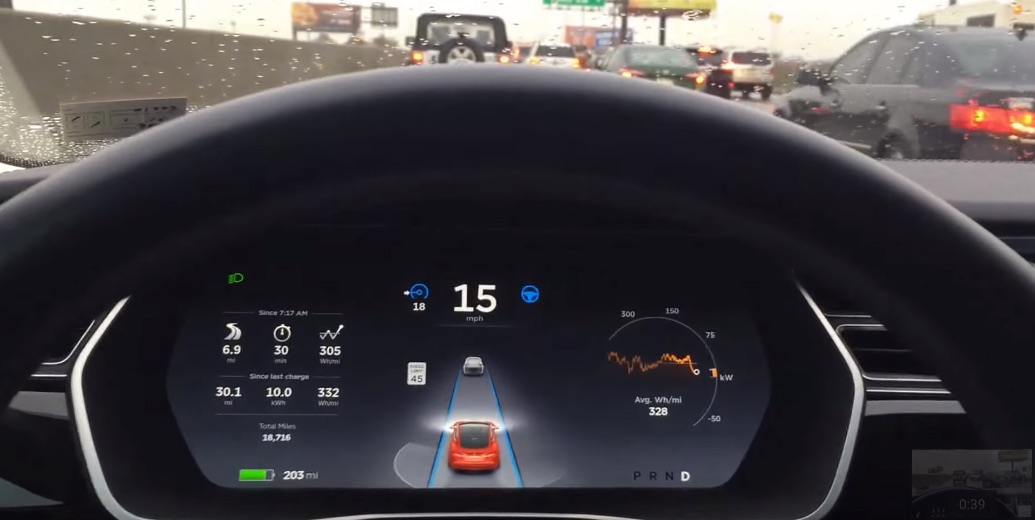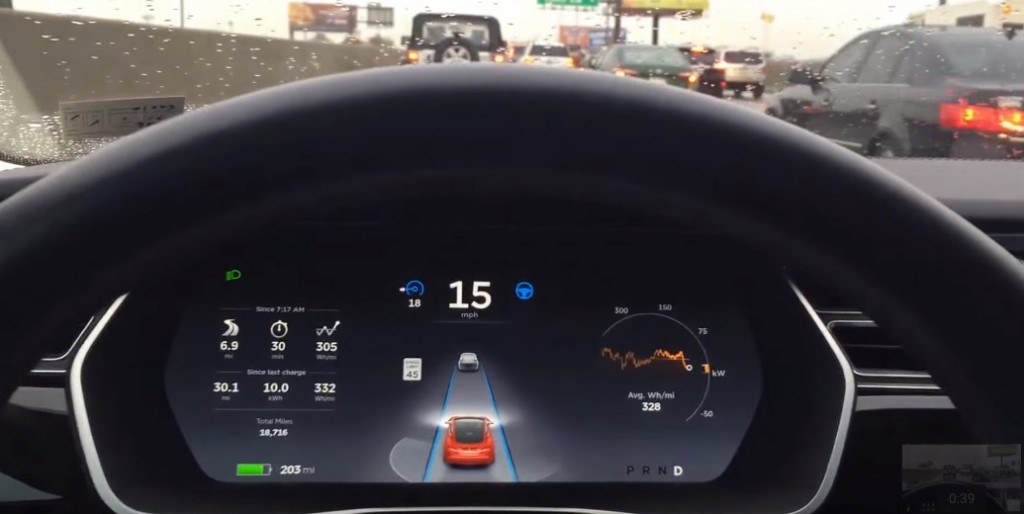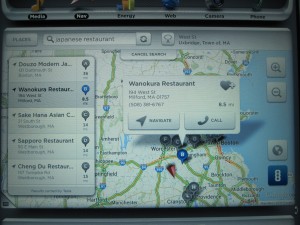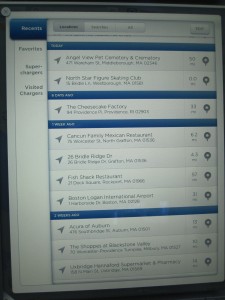News
How will Tesla Version 8 compare to current Autopilot in the real world?

Tesla’s upcoming Version 8 software will be the company’s most significant Autopilot upgrade since its October 2014 initial release, but how will these updates compare to current Autopilot behavior in the real world?
This will be the first time the company will switch from using the vehicle’s front-facing camera as the core hardware responsible for visual image recognition, to radar technology which will now become the primary sensor used in creating a virtual picture of the vehicle’s surroundings.
With these improvements, to be rolled out via an over-the-air software update in the coming weeks, Model S equipped with the Autopilot hardware suite and Model X should theoretically be able to handle emergency braking situations with more precision, provide a smoother Traffic Aware Cruise Control (TACC) experience, take highway exits on its own, and provide drivers and passengers with an overall safer experience.
Let’s take a look at each of these features and see how Autopilot in Version 8 will differ from current Version 7 capabilities.
Automatic Emergency Braking
Following the much publicized death of Joshua Brown after his Model S crashed into the side of a tractor trailer while driving on Autopilot, reliability of Autopilot’s Automatic Emergency Braking (AEB) feature was immediately put to question. Tesla released a statement stating that the high, white side of the tractor trailer, combined with a radar signature that would have looked very similar to an overhead sign, caused automatic braking not to fire. “Since January 2016, Autopilot activates automatic emergency braking in response to any interruption of the ground plane in the path of the vehicle that cross-checks against a consistent radar signature,” said Tesla.
Spy shots taken from the Naval Air Station reveal Tesla was testing and calibrating its AEB system this past summer. But despite the tests which seemingly show a Model S automatically braking in a staged collision event, Tesla has been overly cautious when it comes to activation of its AEB feature. AEB is reliant on imagery received from its front-facing camera, and supplemented by radar input, to decide on the degree of confidence that would trigger a braking event.
Some Tesla owners have even taken it upon themselves to stage scenarios that would seemingly trigger the AEB response of the vehicle, but to no avail leaving further mystery as to how AEB works.
The current Autopilot system under Version 7 is limited in its ability to reliably detect people or pinpoint false positives such as reflective objects that may appear larger than they are. Tesla uses the concave bottom of a soda can as an example. When the radar signal is reflected back from the can’s bottom dish-shaped surface, the reflected signal is amplified to many times its actual size leading the radar to believe there’s a large object before it. Because of that, programming the AEB system to suddenly engage could lead to a dangerous situation so Tesla decided to limit the scenarios that could actually trigger an automatic emergency braking response.
However, Version 8 will combine the power of fleet learning with “radar snapshots” to improve the vehicle’s ability to more accurately depict the circumstances of an event. In other words, we can expect Autopilot under Version 8 to have a much higher degree of confidence when it comes to engaging automatic emergency braking. Tesla CEO Elon Musk believes this set up will provide safety improvements by a factor of three over existing Autopilot.
Traffic Aware Cruise Control
Beyond being able to track a vehicle that’s directly in front of the car, Version 8 of Autopilot will also be able to see the vehicle ahead of that. Tesla describes this update as follows: Tesla will also be able to bounce the radar signal under a vehicle in front – using the radar pulse signature and photon time of flight to distinguish the signal – and still brake even when trailing a car that is opaque to both vision and radar. The car in front might hit the UFO in dense fog, but the Tesla will not.
The improvement will lead to smoother braking events when TACC is engaged since Autopilot will no longer solely rely on the actions from the vehicle before it. If a hard braking event happened in front of the vehicle that Autopilot is immediately tracking, Version 8 will be able to identify it and slow the Model S (or Model X) even before the vehicle directly ahead may have applied the brakes.
The following video captures an incident whereby the vehicle being tracked by Version 7 of Autopilot could not see the hard braking event that took place two cars ahead. TACC seemingly did not have enough time to stop the Model S.
Being able to see two cars ahead in Version 8 will provide a smoother TACC experience and increased safety.
Improved Auto Lane Change and Freeway Exiting
What we’re particularly excited about is the new feature in Version 8.1 that will allow an Autopilot-equipped Model S and Model X to take highway exits using the onboard navigation system.
Currently, Version 7 of Autopilot is capable of handling lane changes when the driver explicitly uses the turn signal stalk. Signaling left and the vehicle will make a left lane change, and vice versa. However with the ability to punch in a destination through Tesla Nav and have the vehicle assist with freeway exiting, assuming that’s part of the route, in our minds, Tesla is taking a critical step towards the ultimate goal of building fully autonomous self-driving vehicles. It’s a small step, but nonetheless it’s a notable step.
Photo credit: Rob M.
Full details of Tesla Version 8 can be found here.
News
SpaceX’s Crew-11 mission targets July 31 launch amid tight ISS schedule
The flight will lift off from Launch Complex 39A at Kennedy Space Center in Florida.

NASA and SpaceX are targeting July 31 for the launch of Crew-11, the next crewed mission to the International Space Station (ISS). The flight will lift off from Launch Complex 39A at Kennedy Space Center in Florida, using the Crew Dragon Endeavour and a Falcon 9 booster.
Crew Dragon Endeavour returns
Crew-11 will be the sixth flight for Endeavour, making it SpaceX’s most experienced crew vehicle to date. According to SpaceX’s director of Dragon mission management, Sarah Walker, Endeavour has already carried 18 astronauts representing eight countries since its first mission with NASA’s Bob Behnken and Doug Hurley in 2020, as noted in an MSN report.
“This Dragon spacecraft has successfully flown 18 crew members representing eight countries to space already, starting with (NASA astronauts) Bob (Behnken) and Doug (Hurley) in 2020, when it returned human spaceflight capabilities to the United States for the first time since the shuttle retired in July of 2011,” Walker said.
For this mission, Endeavour will debut SpaceX’s upgraded drogue 3.1 parachutes, designed to further enhance reentry safety. The parachutes are part of SpaceX’s ongoing improvements to its human-rated spacecraft, and Crew-11 will serve as their first operational test.
The Falcon 9 booster supporting this launch is core B1094, which has launched in two previous Starlink missions, as well as the private Ax-4 mission on June 25, as noted in a Space.com report.
The four-members of Crew-11 are NASA astronauts Zena Cardman and Mike Fincke, as well as Japan’s Kimiya Yui and Russia’s Oleg Platonov.
Tight launch timing
Crew-11 is slated to arrive at the ISS just as NASA coordinates a sequence of missions, including the departure of Crew-10 and the arrival of SpaceX’s CRS-33 mission. NASA’s Bill Spetch emphasized the need for careful planning amid limited launch resources, noting the importance of maintaining station altitude and resupply cadence.
“Providing multiple methods for us to maintain the station altitude is critically important as we continue to operate and get the most use out of our limited launch resources that we do have. We’re really looking forward to demonstrating that capability with (CRS-33) showing up after we get through the Crew-11 and Crew-10 handover,” Spetch stated.
Lifestyle
EV fans urge Tesla to acquire Unplugged Performance for edge in fleet and security industry
Unplugged Performance has built a name for itself by producing performance upgrades for Tesla vehicles.

A growing number of Tesla enthusiasts and longtime community voices are calling on the electric vehicle maker to acquire Unplugged Performance, a California-based aftermarket company best known for tuning Tesla vehicles and developing specialized government fleet solutions under its UP.FIT division.
The idea was once considered a niche proposal among EV fans, but it is now gaining serious attention not just as a performance play but as a strategic move to deepen Tesla’s roots in the fleet and security industry.
A strategic fit
Unplugged Performance has built a name for itself by producing performance upgrades for Tesla vehicles, from track-optimized components to visual and aerodynamic upgrades. But in recent years, its UP.FIT division has pivoted toward a more functional future by outfitting Tesla vehicles like Model Ys for police, military, and government use.
That work has sparked growing calls for closer collaboration with Tesla, especially as the EV maker increasingly leans into autonomy, AI, and fleet services as core components of its next chapter.
“I posted this four years ago, but I think it’s more true now than ever,” wrote Whole Mars Catalog, a well-known Tesla investor and FSD Beta tester, on X. “Tesla should buy Unplugged. But not just as a Performance division. What they are doing with UP.FIT unlocks large government and commercial fleet purchases that can improve utilization.”
Tesla fans such as shareholder Sawyer Merritt echoed the sentiment, calling Unplugged a “great fit within Tesla.” adding, “They are literally located directly next to Tesla’s design studio in Hawthorne.”
Enabling the next wave
Supporters of the idea noted that integrating Unplugged into Tesla’s corporate structure could help accelerate the adoption of autonomous technologies in government sectors. With UP.FIT patrol cars already in use across some U.S. police departments, Tesla fans envisioned a future where self-driving Teslas could potentially revolutionize law enforcement, search-and-rescue, and public service logistics.
“Just imagine how autonomous patrol cars could transform policing and bring us into a safer future,” the veteran FSD tester wrote.
The benefits could also extend to Tesla’s existing consumer base. “They also have some incredible products in the works that I think will appeal to many ordinary Tesla drivers — not just those looking for performance or mods. Stuff that’s so good it should have come straight from the design studio next door,” Whole Mars Catalog noted.
Unplugged Performance, founded in 2013, shares not just a product vision with Tesla, but also geography. Its Hawthorne headquarters sits directly adjacent to Tesla’s design studio, and the two companies have maintained a close working relationship over the years. The aftermarket firm has long positioned itself as a “mission-aligned” partner to Tesla.
In response to the recent calls for acquisition, Unplugged Performance acknowledged the support from the community. “Our very existence is to support the Tesla mission with @UpfitTesla and @UnpluggedTesla,” Unplugged CEO Ben Schaffer posted on X. “We love working with Tesla and are grateful for the community’s support since 2013!”
News
Tesla debuts hands-free Grok AI with update 2025.26: What you need to know
All new Tesla vehicles delivered on or after July 12, 2025, will include Grok AI out of the box

Tesla has begun rolling out Grok, an in-car conversational AI assistant developed by xAI, to eligible vehicles starting July 12. The feature marks the most direct integration yet between Elon Musk’s artificial intelligence startup and Tesla’s consumer product lineup, offering drivers hands-free access to a chat-style companion while on the road.
Grok comes pre-installed on new vehicles
According to Tesla’s FAQ page for the feature, all new vehicles delivered on or after July 12, 2025, will include Grok AI out of the box. Owners of older vehicles may gain access through an over-the-air update, provided their vehicle meets a few hardware and software requirements.
Specifically, Grok is currently only supported on Tesla models equipped with an AMD infotainment processor and running vehicle software version 2025.26 and higher. Compatible models include the Model S, Model 3, Model X, Model Y, and Cybertruck. A Premium Connectivity subscription or active Wi-Fi connection is also required.
Tesla notes that additional vehicle compatibility may arrive in future software updates.
Grok’s features and limitations for now
Drivers can engage with Grok using the App Launcher or by pressing and holding the voice command button on the steering wheel. Grok is designed to answer questions and hold conversations using natural language, offering responses tailored to its chosen personality—ranging from “Storyteller” to the more eccentric “Unhinged.”
For fun, Tesla posted a demonstration of Grok likely running on “Unhinged” talking about what it would do to Optimus when they are on a date, much to the shock of the humanoid robot’s official social media account.
It should be noted, however, that Grok cannot currently issue commands to the vehicle itself, at least for now. Traditional voice commands for tasks like climate control, navigation, or media remain separate from Grok as of writing.
The feature is being released in Beta and does not require a Grok account or xAI subscription to activate, although that policy may change over time.
Grok privacy and in-car experience
Tesla emphasizes that interactions with Grok are securely processed by xAI and not linked to a user’s Tesla account or vehicle. Conversations remain anonymous unless a user signs into Grok separately to sync their history across devices.
Tesla has also begun promoting Grok directly on its official vehicle webpages, showcasing the feature as part of its in-car experience, further highlighting the company’s increasing focus on AI and infotainment features on its all-electric vehicles.
-

 Elon Musk2 weeks ago
Elon Musk2 weeks agoTesla investors will be shocked by Jim Cramer’s latest assessment
-

 Elon Musk3 days ago
Elon Musk3 days agoxAI launches Grok 4 with new $300/month SuperGrok Heavy subscription
-

 Elon Musk5 days ago
Elon Musk5 days agoElon Musk confirms Grok 4 launch on July 9 with livestream event
-

 News1 week ago
News1 week agoTesla Model 3 ranks as the safest new car in Europe for 2025, per Euro NCAP tests
-

 Elon Musk1 week ago
Elon Musk1 week agoxAI’s Memphis data center receives air permit despite community criticism
-

 News2 weeks ago
News2 weeks agoXiaomi CEO congratulates Tesla on first FSD delivery: “We have to continue learning!”
-

 Elon Musk2 weeks ago
Elon Musk2 weeks agoTesla scrambles after Musk sidekick exit, CEO takes over sales
-

 News2 weeks ago
News2 weeks agoTesla sees explosive sales growth in UK, Spain, and Netherlands in June




















